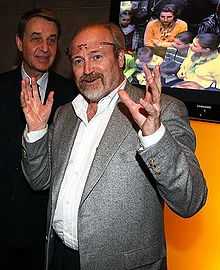Vladimir Khotinenko
| Vladimir Khotinenko | |
|---|---|
 | |
| Born |
Vladimir Ivanovich Khotinenko 20 January 1952 Slavgorod, Altai Krai, USSR |
| Occupation | actor, film director, designer |
| Years active | 1979–present |
| Spouse(s) | Tatyana Yakovleva |
Vladimir Ivanovich Khotinenko (Russian: Влади́мир Ива́нович Хотине́нко; born 20 January 1952 in Slavgorod, Altai Krai, Soviet Union) is a Russian actor, film director and designer.
Biography
In 1976, he received his diploma from the Institute of Architecture of Sverdlovsk, in what is now Ekaterinburg. After his military service, he was from 1978 to 1982, assistant designer at Studio-Film in Sverdlovsk, and was assistant director for the film by Nikita Mikhalkov, Days in the Life of Oblomov. He collaborated on other films by Mikhalkov in Moscow, such as Five Nights (Пять вечеров) 1979, and Family Relations (Родня) 1981.
He then became director of the Gerasimov Institute of Cinematography in Moscow. His 1999 film Strastnoy Boulevard was entered into the 21st Moscow International Film Festival where it won a Special Mention.[1]
He excelled in historical films and large scenes, particularly describing the history of Russia. He won the Golden Eagle in 2004 for 72 Metres.[2]
Filmography
Actor:
- 1981 Family Relations (Родня)
- 1982 Kazachya zastava (Казачья застава)
- 1988 The Soloist
- 1994 A Plane Flies in Russia
Director:
- 1984 Alone and Unarmed
- 1987 Mirror for a Hero
- 1990 The Swarm
- 1992 Patriotic Comedy
- 1993 Makarov
- 1995 A Moslem
- 1999 Strastnoy bulvar (producer)
- 2002 Po tu storonu volkov
- 2003 Sledstvie vedut znatoki 23: Treteyskiy sudiya
- 2004 72 Meters
- 2004 The Fall of the Empire (screenwriter)
- 2007 1612
- 2009 The Priest
- 2011 Dostoyevsky (TV series)
References
- ↑ "21st Moscow International Film Festival (1999)". MIFF. Retrieved 2013-03-24.
- ↑ "Laureates of the 2004 Golden Eagle Award" (in Russian). Official Golden Eagle Award website. Retrieved 2009-11-16.
External links
|